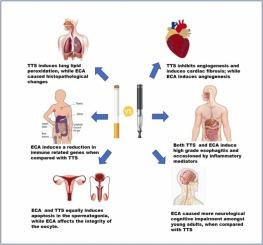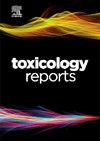替代烟草制品(电子烟)和传统烟草吸烟对各种器官/系统的比较影响:给监管机构和卫生政策制定者的指南。
Q1 Environmental Science
引用次数: 0
摘要
传统吸烟(TTS)在全球范围内被认为是一系列疾病的单一最大可避免风险因素。一个多世纪以前,烟草卷烟广泛传播,尤其是源自美洲;以及最近的替代烟草产品,如电子烟气溶胶(ECA)和无烟烟草。这是由于后者被认为是安全的。有若干迹象表明,频繁使用电子烟可能造成直接和间接的健康威胁,需要紧急制定监管规定,特别是在资源有限的情况下。本综述的数据是通过对PubMed、Elsevier、b谷歌scholar和Scopus等科学文献的严格搜索得到的。电子烟对健康的有害影响主要与电子烟汁或电子烟液有关,其中主要含有尼古丁、调味剂、丙二醇和其他不受管制的添加剂。在呼吸系统中,TTS和ECA引起肺巨噬细胞计数增加和细胞内流增加。然而,TTS引起更高的脂质过氧化,而ECA引起肺组织学的负向转变,其特征是肺泡空间体积密度增加。涉及心血管系统的研究探索了尼古丁等与动脉粥样硬化有关的成分;心脏组织重塑和丙二醇的心脏毒性热代谢产物。在心脏组织重塑方面,ECA引起小鼠心脏组织血管生成显著增加,同时胶原蛋白生成增加,但未引起组织纤维化。这表明急性暴露于ECA对收缩功能或纤维化没有不利影响。然而,这与TTS相反,TTS显示抑制血管生成和诱导心脏纤维化。与TTS相比,在年轻人中越来越多地使用ECA显示出更大的神经缺陷倾向,这主要是由于尼古丁、调味剂、甲醛等的联合神经毒性作用,对认知和注意力持续时间造成负面影响。综上所述,这些不受管制和令人上瘾的产品无节制地传播,在资源有限的国家造成质量保证不一致,从而造成公共卫生风险。因此,迫切需要对这些产品进行监管,并对电子烟的长期安全性进行进一步研究,而国家卫生监管机构和决策者应就电子烟和其他替代烟草产品的使用提供知情的政策。本文章由计算机程序翻译,如有差异,请以英文原文为准。

COMPARATIVE EFFECTS OF ALTERNATE TOBACCO PRODUCT (ELECTRONIC CIGARETTE) AND TRADITIONAL TOBACCO SMOKING ON VARIOUS ORGAN/SYSTEMS: A GUIDE TO REGULATORS AND HEALTH POLICY MAKERS.
Traditional Tobacco smoking (TTS) is globally known as the single largest avoidable risk factor for a broad range of diseases. Over a century ago, there has been a wide spread of tobacco cigarettes, originating particularly from the Americas; and most recently alternative tobacco products, such as e-cigarettes aerosol (ECA) and smokeless tobacco. This is due to the perceived safety of the latter. There are several indications that frequent e-cigarette use causes possible direct and indirect health threats, requiring urgent regulatory provisions particularly in resource constrain setting. Data for this review were gotten through a rigorous search of scientific literatures on PubMed, Elsevier, Google scholar and Scopus. The deleterious health effects of ECA have been linked largely to the e-juice or e-liquid which majorly contains nicotine, flavorings, propylene glycol and other unregulated additives. In the respiratory system, TTS and ECA cause increase in pulmonary macrophage count and higher cell influx. However, TTS caused a higher lipid peroxidation, while ECA caused a negative shift in the histology of the lungs, featuring an increase in volume density of the alveolar space. Studies involving the cardiovascular system explored the constituents such as nicotine, linked to atherosclerosis; cardiac tissue remodeling and cardiotoxic thermal metabolites of propylene glycol. On cardiac tissue remodeling, ECA caused significant increase in angiogenesis in mouse heart tissues, coupled with increase collagen production but not tissue fibrosis. This suggests that acute exposure to ECA did not adversely affect contractile functions or fibrosis. However, this was contrary with TTS, which showed inhibition of angiogenesis and induction of cardiac fibrosis. The increasing use of ECA amongst young adults showed more tendency for neurological defects when compared with TTS, this is mainly due to combinatory neurotoxic effects of nicotine, flavorings, formaldehyde, etc., causing a negative effect on cognition and attention span.
Putting these together, Uncontrolled spreading of these unregulated and addictive products is creating inconsistent quality assurance in resource constrain countries resulting in public health risk. There is therefore an urgent need for the regulation of these products and further research carried out on long-term safety of e-cigarettes, while national health regulators and policy makers should provide informed policies on the use of e-cigarettes and other alternative tobacco products.
求助全文
通过发布文献求助,成功后即可免费获取论文全文。
去求助
来源期刊

Toxicology Reports
Environmental Science-Health, Toxicology and Mutagenesis
CiteScore
7.60
自引率
0.00%
发文量
228
审稿时长
11 weeks
 求助内容:
求助内容: 应助结果提醒方式:
应助结果提醒方式:


